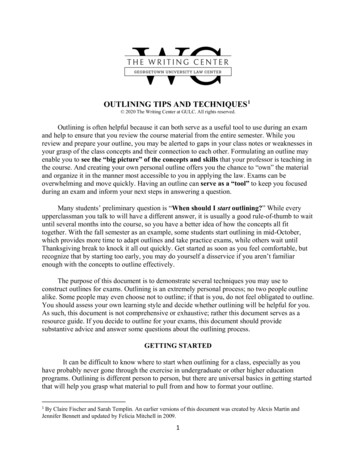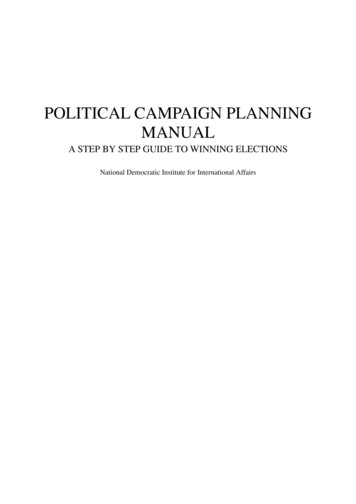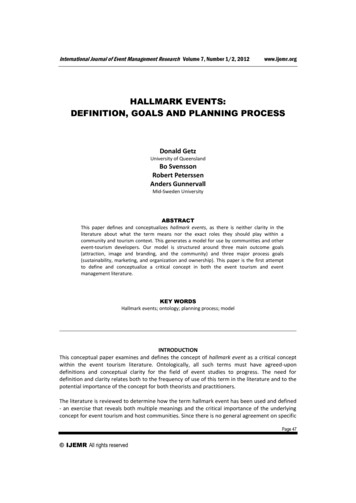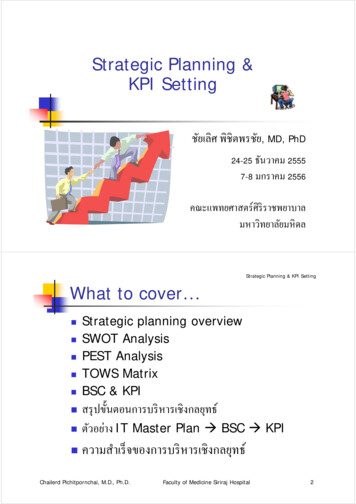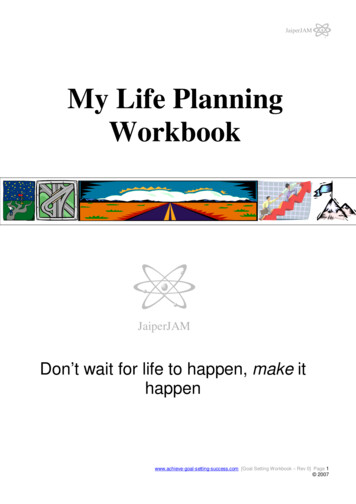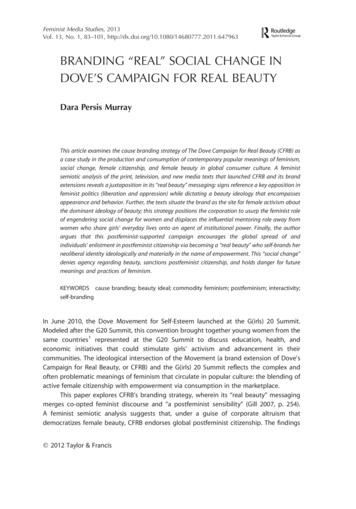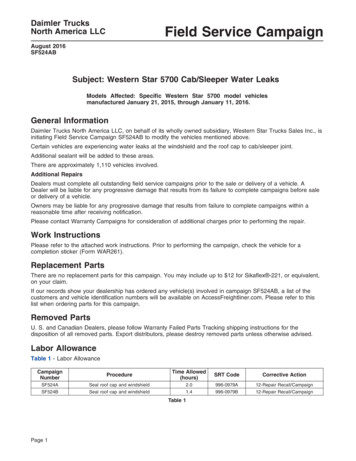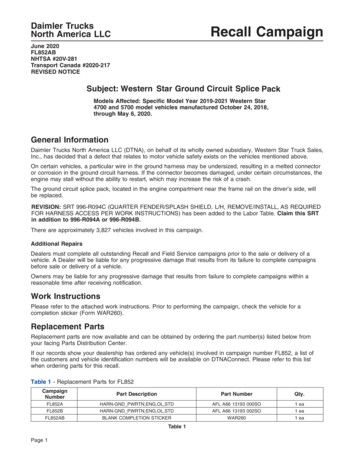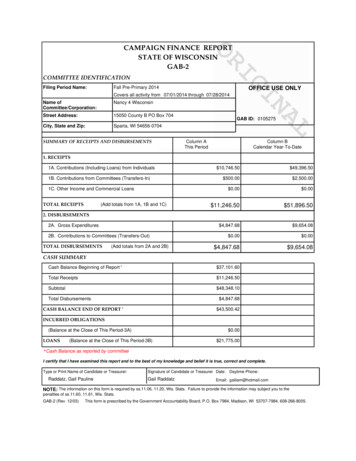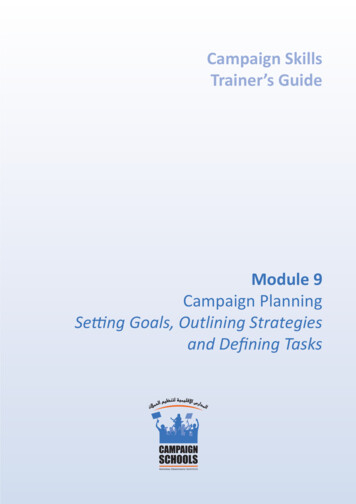
Transcription
Campaign SkillsTrainer’s GuideModule 9Campaign PlanningSetting Goals, Outlining Strategiesand Defining Tasks
CAMPAIGN SKILLS TRAINER’S GUIDEMODULE 9: CAMPAIGN PLANNINGSetting Goals, Outlining Strategies and Defining TasksSESSION OVERVIEW:This module provides a step-by-step guide to organizing a successful political campaign including setting goals,assessing needed resources of people, money and time, and creating a timeline, budget, and written plan.SECTIONS:1. Campaign Planninga. Setting a Goalb. Budgets and Financial Resource Managementc. Timeline and Time Managementd. Staffing and Human Resource Management2. Data and List Management3. Volunteer Recruitment and ManagementLEARNING OBJECTIVES:- Skills and tools for campaign planning and managing resourcesTIME: 160 minutesMATERIALS:- Flipchart and paper, markers and tape- Training agenda (optional – can be written on the flipchart)HANDOUTS:- Campaign Budget Template- Campaign Timeline Template- Campaign Team Job DescriptionsPREPARATION:Write on the flipchart in advance:1. Agenda (optional – if it is not copied)2. Learning Objectives3. CAMPAIGN RESOURCES:- People- Money- Time- InformationModule 9: Campaign Planning1
4. CAMPAIGN PLAN IS A WRITTEN DOCUMENT THAT DEFINES- WHAT you are going to achieve- HOW you are going to achieve it5. ELEMENTS OF A CAMPAIGN PLAN:- GOAL- TIMELINE AND ACTION PLAN- BUDGET AND FUNDRAISING- MESSAGE- MEDIA AND COMMUNICATION- CAMPAIGN TEAM- VOTER CONTACT6. 5 STEPS FOR ORGANIZING A CAMPAIGN TEAM:- Identify activities- Identify Functions and Skills- Write Job Descriptions- Recruit- Assign Roles7. SOURCES OF INFORMATION:- The official voter list- Contact lists from candidates- Contact lists from supporters- Contact lists from the party- Campaigns build their own8. Volunteer is work done freely and without compensation to benefit one’s community9. Reasons to volunteer:- Shared belief- New knowledge- Expectations- Socializing- Recognition10. Where are volunteers?- Family and friends- Local schools and universities- Local civic or religious organizations- Among supporters who can’t give money2Module 9: Campaign Planning
KEY FOR THE TYPE OF ACTIVITIES INCLUDED IN THIS WORKSHOP:TP – Trainer’s PresentationPEE – Participants’ Experiences or ExercisesDBR – Facilitated Discussions, Brainstorming and ReflectionCLL – Conclusions and Lessons LearnedANK – Application of New KnowledgeModule 9: Campaign Planning3
TRAINING ACTIVITIESSECTION 1 – Campaign Planning: Introduction – 10’StepsDescriptionIntroduce the session and review learningobjectives.1Type MinTP3Note to the TrainerA number of the elements of a campaignplanning are fully developed andexplained in other modules from NDI’sMENA Campaign School Curriculumincluding: message, fundraising, mediaand communication and voter contact.This session will focus on the remainingelements of a campaign plan (goal, timelineand action plan, budget, and campaignteam) and two other topics relevantfor managing resources: Data and ListManagement and Volunteer Recruitmentand Management.Introduction to Campaign Planning:CAMPAIGN RESOURCES:Remember, every campaign has four mainresources:PEOPLE-PeopleMoneyTimeInformation 2 INFORMATION- WHAT you are going to achieve- HOW you are going to achieve itTP7ELEMENTS OF A CAMPAIGN PLAN:A campaign plan is a written documentthat charts what you are going to achievein your electoral campaign and how youare going achieve it. It is a roadmap thatwill guide you and your team through thebusy and challenging days of the campaignand election, help make sure you have allthe resources you need and ensure you areconducting the types of activities that willget you to your goal.4TIMECAMPAIGN PLAN IS A WRITTENDOCUMENT THAT DEFINESCampaign planning is about managingall of these effectively so that no matterhow resource-rich or resource-poor yourcampaign is, you can maximize your impactand potential to win.MONEYModule 9: Campaign Planning-GOALTIMELINE AND ACTION PLANBUDGET AND FUNDRAISINGMESSAGEMEDIA AND COMMUNICATIONCAMPAIGN TEAMVOTER CONTACT
StepsDescriptionIf the plan is not written down on a pagesomewhere, then it cannot come to life.If it cannot be shared with other teammembers, then it cannot be implemented.If it cannot be referred to in times of crisis,then it cannot guide your efforts.Type MinNote to the TrainerThere are many ways to construct a campaign plan, and how you do this in practice should reflectyour own needs and assets, the type of election you are facing and what the election law allows.However, the following elements should be considered and included within this context, and shouldwork together as the building blocks that get you to your goal:Goal: Your campaign goal is a clear statement of what you want to achieve. Do you need to“top the poll,” i.e., receive more votes than any other candidate on the ballot? Do you want toincrease your party’s support in the area by 5%? Are you running for better name recognition inthis race, with the goal of winning a seat in the next election? Your goal should be a short, welldefined declaration of what you realistically want to accomplish.Timeline and Action Plan: The timeline and action plan outline what you are going to do on adaily basis and measure out how much time you will need to implement all your activities andthe components of your campaign.Budget and Fundraising: Your budget clearly outlines how much money or other materialresources you will need to implement the campaign. The fundraising component maps out howyou are going to find them.Message: Your message is your statement of purpose that communicates to voters who youare, what you stand for, and what makes you different from other candidates in the race.The message elements of your plan define this statement and lay out how and when you willcommunicate your message.Media and Communication: This is your external communication strategy that defines how youwill use conventional and newer media to communicate with voters and raise your profile.Campaign Team: How many people do you need? What will their roles be? Can you afford paidstaff or will you have to recruit volunteers? How big will your team need to be? The campaignteam element of your plan answers these questions so that you have the right human resourcesto implement your strategy effectively.Voter Contact: Your voter contact strategy calculates how many votes you will need to win orreach your goal, where you can find those votes and how you will communicate directly withsupporters and potential supporters, and ensure they will cast their ballots on election day.Module 9: Campaign Planning5
SECTION 1a – Campaign Planning: Setting a Goal – 15’Steps1DescriptionAsk the participants to give you examplesof electoral campaign goals. Facilitate thediscussion and write their answers on theflipchart. If needed, you can bring up thefollowing or some other examples:Type MinTo win two more parliamentaryseats in this district by picking up thelargest percentage of first-time andswing votersTo obtain the highest number ofindividual votes as a candidate on myparty’s list (in the open list system) inthis districtDBRTo increase my party’s support in thearea by 3%, enough to be one of theparties in government in the regionalassemblyTo get elected to the local council thisyear and to raise my profile enoughthat I will be selected as mayor withinthe next four years7Note to the TrainerWhen you ask this question the very firstimpulse and response people give is: to winthe election. After you write this answeron the flipchart ask about parties thathold less than 10% of seats in parliamentfor example and have strong support in aspecific region of the co untry. Would theirgoal, realistically, be to win more than 50%of the seats. What is more likely to be theirgoal?Facilitate this brainstorm leading thediscussion towards the conclusion thateach contestant in the election shouldhave a realistic goal. This goal shouldclearly define what it is the campaignseeks to achieve, and clarify why it is worthparticipating in the election.Wrap up this brainstorming by saying:Different campaigns might define“winning” differently. What’s important isclearly envisioning the outcome you want,and setting a specific goal to get there.Divide participants into groups of no morethan 5 people. Provide each group withflipchart paper and a marker.How you divide the groups will dependon who your participants are. If you havepeople who are working on the samecampaign or for the same candidate, itmakes sense to group them together sothat they can easily apply the work they aredoing in the training to their campaigns.Ask each group to define their campaign’sgoal and write it down on the flipchartpaper, and present it to the larger group.2ANKIf it’s helpful, ask participants to imageit’s election day. What does it look likefor their campaign? What have theyachieved? A goal is a statement of whatyou seek to achieve.68If participants are from more diversebackgrounds, consider assigning them tocampaign teams for mock candidates ora mock election. Telling them their goalis to work together to build an effectivecampaign plan for their team.Module 9: Campaign Planning
SECTION 1b – Campaign Planning: Budgets and Financial Resource Management – 40’StepsDescriptionExplain to participants that ones you havedefined your goal, the next step is to figureout what resources you are going to needto have in place to achieve this goal.Make the following points:Type MinSince no campaign has as much money asit would like, a budget is a tool to help youmake sound strategic decisions about whatis most important and what will have themost impact.1You need to write the budget to have aclear picture on:- how much resources you need intotal for a campaign- when you need them- how much you have- how much you need to raise- cash flowTP10Note to the TrainerMake sure participants understand that alarge part of what a campaign budget triesto track is cash flow. Campaigns need toknow not only how much money and otherresources they are going to need, but alsowhen they are going to need them to guidefundraising and other resource generatingefforts.Most campaigns need more cash at thebeginning to get started and then again atthe end of the campaign period to finishstrong and get out their vote. Adviseparticipants to use their budgets to trackwhen they can expect to get income into pay bills and when they will have tobe particularly careful with spending topreserve resources.Distribute the Campaign Budget Templatehandout and walk participants througheach area, making sure the differencesbetween income, expenses and cash flowin particular are understood.Ask participants to return to (or remainin) their groups. Provide each group withflipchart paper and markers (these areoptional for them to use; they can workoff the budget template handout if theyprefer.)2Advise each team that they have aprojected budget of 12,000 for theupcoming election. As a team, they needANKto figure out where they are going to spendthis money and when they are going toneed it in order to achieve the goal theydefined in the previous exercise.Please feel free to change the amountand currency of the budget given in thisassignment to match local realities.30It may be helpful to explain that inbudgeting, some costs will fall into morethan one line item. For example, thecosts of phones and phone cards willaffect all activities including fundraising,communication and voter contact.Purchasing and formatting the voter list, orbuilding a voter database, will impact allvoter contact and GOTV expenses. Adviseparticipants to use specific line items(such as phones or voter list) to estimatethe exact cost of these expenses, and usebroader categories (such as canvassing andGOTV) to estimate the additional costs ofconducting these activities.Module 9: Campaign Planning7
StepsDescriptionTeams can use the Campaign BudgetTemplate as a guide but should edit thetemplate to remove items which will notbe relevant to their campaign and to additems that they will need to pay for whichare not already listed.Allow 20 minutes for teams to completethe activity, and 10 minutes to presenttheir work.8Type MinNote to the TrainerConsider giving the groups the home taskof completing the complete budget fortheir own campaigns. In this case, assigna specific person from each team to reportback to you on a specific date and createa mechanism (such as email, Skype or aphone call) to provide each team withfeedback.Module 9: Campaign Planning
SECTION 1c – Campaign Planning: Timeline and Time Management – 35’StepsDescriptionType MinNote to the TrainerRefer back to a campaign’s 4 main resourcesYou can have the campaign timeline sampleand point out once again that while eachon the flipchart:campaign and each candidate will haveDate Activity Who’s VolunteersOtherdifferent amount of money and information,Respon- Needed? Resources?and different number of volunteers,sible?HowMoney,the amount of time is the same for allMany?Leaflets,Banners,contestants – it is the period from todayTP5Food,etc.until the Election Day. Using this time wellcan give a campaign a real advantage, whichE-Dayis why creating a timeline matters.Explain the importance and thecomponents of a timeline:1A detailed timeline helps you think through everything the campaign needs to complete during theofficial campaign and pre-campaign periods, and when it needs to be accomplished. A strong timelinewill ensure that you are maximizing time as a resource and not wasting precious moments engagingin activities that don’t get you to your goal.The best way to write a timeline is to start from the goal you defined for election day in the first sectionof this module and work backwards, detailing all the steps you will have to take in order to make it tothis goal. A campaign’s plan will include voter contact activities, new and traditional media outreach,and fundraising tasks. Break down your larger goals
- VOTER CONTACT 6. 5 STEPS FOR ORGANIZING A CAMPAIGN TEAM: . make sound strategic decisions about what is most important and what will have the most impact. You need to write the budget to have a clear picture on: - how much resources you need in total for a campaign - when you need them - how much you have - how much you need to raise - cash flow Distribute the Campaign Budget
